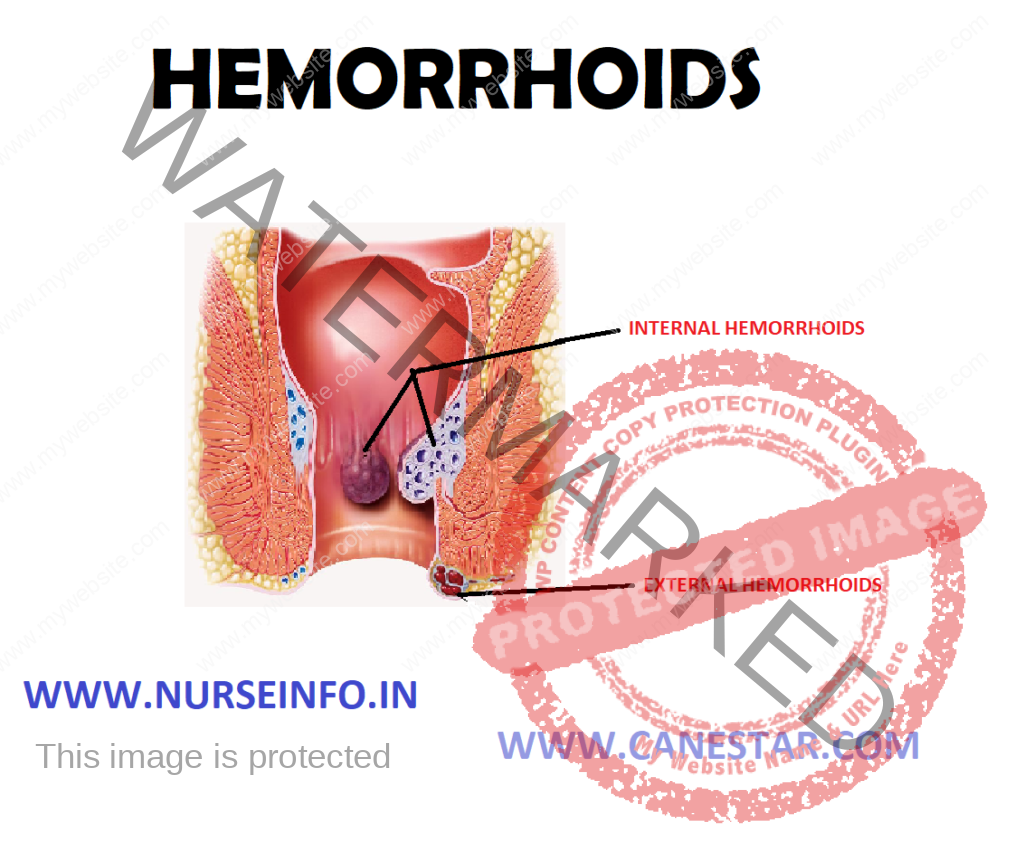HEMORRHOIDS – Etiology, Types, Pathophysiology, Diagnostic Evaluation and Management
Hemorrhoids are enlarged veins in the anus or lower rectum. These comprise the blood supply to the anus and distal rectum
ETIOLOGY
- Constipation
- Diarrhea
- Lack of exercise
- Nutritional factors (low-fiber diets)
- Increased intra-abdominal pressure
- Genetics
- Aging
- Obesity
- Prolonged sitting
- Chronic cough
- Pregnancy
TYPES
- External hemorrhoids appear on the outside of the anus, especially around the anal opening. They too can cause a lot of discomfort because of constant friction with clothes, etc
- Prolapsed hemorrhoids basically represent a later stage in the development cycle of internal hemorrhoids. When the latter become too bulky due to clogging of the vein with blood, they begin to sag and consequently protrude from the anus
- Bleeding hemorrhoids are also a more severe form or stage of internal hemorrhoid characterized by profuse bleeding
PATHOPHYSIOLOGY
Normal vascular cushion —- downward pressure during defecation —- muscle fiber-anchored hemorrhoids loosen —- hemorrhoids tissue slides, then congested bleeds —- prolapse
DIAGNOSTIC EVALUATION
- Examination of anal canal and rectum for abnormalities
- Visual inspection of anal canal and rectum
MANAGEMENT
Medications
If hemorrhoids produce only mild discomfort, over-the-counter creams, ointments, suppositories or pads are recommended. These products contain ingredients, such as hydrocortisone, that can relieve pain and itching
Surgical Management
- Rubber band ligation: one or two tiny rubber bands around the base of an internal hemorrhoid are placed to cut-off its circulation. The hemorrhoid withers and falls off within a week
- Sclerotherapy: in this procedure, injection of a chemical solution is introduced into the hemorrhoid tissue to shrink it. While the injection causes little or no pain, it may be less effective than rubber band ligation
- Coagulation (infrared, laser or bipolar): coagulation techniques use laser or infrared light or heat. They cause small, bleeding, internal hemorrhoids to harden and shrivel
- Hemorrhoidectomy: during a hemorrhoidectomy, removal of excessive tissue causes bleeding. Various techniques may be used. The surgery may be done with a local anesthetic combined with seduction, a spinal anesthetic or a general anesthetic. Hemorrhoidectomy is the most effective and complete way to treat severe or recurring hemorrhoids
- Hemorrhoid stapling: this procedure, called stapled hemorrhoidectomy or stapled hemorrhoidopexy, blocks blood flow to hemorrhoidal tissue. Stapling generally involves less pain than hemorrhoidectomy and allows an earlier return to regular activities.
NURSING MANAGEMENT
Preoperative Care
- Give soaking seat
Rationalization: reduce local discomfort, reduce edema and promote healing
- Give lubricant during defecation wound
Rationalization: assist in the conduct of defecation so it does not need straining.
- Give a diet low in residual
Rationalization: reduce stimulation of the anus and weaken the feces
- Instruct the patient to do a lot of standing or sitting (must be in balance)
Rationalization: the force of gravity will affect the incidence of hemorrhoids and sitting can increase intra-abdominal pressure
- Observation of patient complaints
Rationalization: it helps to evaluate the degree of discomfort and lack of effectiveness of actions or states of complications
- Provide an explanation of the emergence of pain and explain briefly
Rationalization: education about it helps in patient’s participation to prevent and reduce pain
- Give the patient suppository
Rationalization: it can soften and can enable the patient to avoid straining during defecation
Postoperative Care
- Give the patient a pleasant sleeping position
Rationalization: may decrease the pressure on the abdomen and increase the sense of control
- Change the bandage every morning according to aseptic techniques
Rationalization: protecting the patient from cross examination during replacement of bandages. Wet bandage acts as a absorber of external contamination and causes discomfort
- Exercise as early as possible
Rationalization: it can reduce the problems that occur due to immobilization
- Observation of the rectal area if there is bleeding
Rationalization: bleeding on the network may increase the pain
- Provide an explanation of the purpose of installation of flue-anus
Rationalization: knowledge of the benefits of the chimney can make the patient understand the anus to funnel anus to cure the wound
Postoperative Complications
Most patients are satisfied with the results of the surgery and recover without any problems. Complications associated with hemorrhoidectomy are rare and include:
- Anal fistula or fissure
- Constipation
- Excessive bleeding
- Excessive discharge of fluid from the rectum
- Fever of 101 degree F or higher
- Inability to urinate or have a bowel movement
- Severe pain, especially when having a bowel movement
- Severe redness and swelling in the rectal area
Nursing Diagnosis
- Ineffective breathing pattern related to decreased pressure inspiration, expiration for anesthetic agent administration
- Fluid volume and electrolyte deficit related to lack of or loss of fluid volume during surgery
- Risk for injury related to the effects of anesthesia and weakness
- Risk for hypothermia related to multiple factors of age, body weight, factors trauma, neuromuscular and environment
Nursing Interventions
- Administer local anesthetic as prescribed
- As needed, provide warm sitz baths or cold compresses to reduce local pain, swelling, and information
- Provide the patient with high-fiber diet and encourage adequate fluid intake and exercise to prevent constipation
- Monitor the patient’s pain level and the effectiveness of the prescribed medications
- Check for signs and symptoms of anal infection, such as increased pain and foul-smelling anal drainage
- Teach the patient about hemorrhoidal development, predisposing factors and test
- Encourage the patient to eat high-fiber diet to promote regular bowel movement
- Emphasize the need for good anal hygiene. Caution against vigorous wiping with washcloths and using harsh soaps
- Encourage the use of medicated astringent pads and toilet paper without dyes or perfumes.


